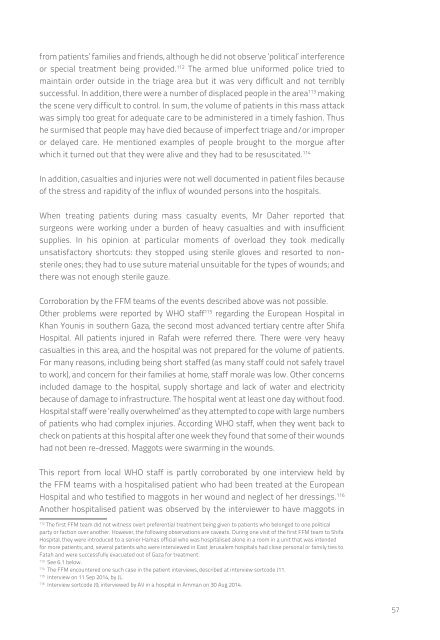HHo0s
HHo0s
HHo0s
Create successful ePaper yourself
Turn your PDF publications into a flip-book with our unique Google optimized e-Paper software.
from patients’ families and friends, although he did not observe ‘political’ interferenceor special treatment being provided. 112 The armed blue uniformed police tried tomaintain order outside in the triage area but it was very difficult and not terriblysuccessful. In addition, there were a number of displaced people in the area 113 makingthe scene very difficult to control. In sum, the volume of patients in this mass attackwas simply too great for adequate care to be administered in a timely fashion. Thushe surmised that people may have died because of imperfect triage and/or improperor delayed care. He mentioned examples of people brought to the morgue afterwhich it turned out that they were alive and they had to be resuscitated. 114In addition, casualties and injuries were not well documented in patient files becauseof the stress and rapidity of the influx of wounded persons into the hospitals.When treating patients during mass casualty events, Mr Daher reported thatsurgeons were working under a burden of heavy casualties and with insufficientsupplies. In his opinion at particular moments of overload they took medicallyunsatisfactory shortcuts: they stopped using sterile gloves and resorted to nonsterileones; they had to use suture material unsuitable for the types of wounds; andthere was not enough sterile gauze.Corroboration by the FFM teams of the events described above was not possible.Other problems were reported by WHO staff 115 regarding the European Hospital inKhan Younis in southern Gaza, the second most advanced tertiary centre after ShifaHospital. All patients injured in Rafah were referred there. There were very heavycasualties in this area, and the hospital was not prepared for the volume of patients.For many reasons, including being short staffed (as many staff could not safely travelto work), and concern for their families at home, staff morale was low. Other concernsincluded damage to the hospital, supply shortage and lack of water and electricitybecause of damage to infrastructure. The hospital went at least one day without food.Hospital staff were ‘really overwhelmed’ as they attempted to cope with large numbersof patients who had complex injuries. According WHO staff, when they went back tocheck on patients at this hospital after one week they found that some of their woundshad not been re-dressed. Maggots were swarming in the wounds.This report from local WHO staff is partly corroborated by one interview held bythe FFM teams with a hospitalised patient who had been treated at the EuropeanHospital and who testified to maggots in her wound and neglect of her dressings. 116Another hospitalised patient was observed by the interviewer to have maggots in112The first FFM team did not witness overt preferential treatment being given to patients who belonged to one politicalparty or faction over another. However, the following observations are caveats. During one visit of the first FFM team to ShifaHospital, they were introduced to a senior Hamas official who was hospitalised alone in a room in a unit that was intendedfor more patients; and, several patients who were interviewed in East Jerusalem hospitals had close personal or family ties toFatah and were successfully evacuated out of Gaza for treatment.113See 6.1 below.114The FFM encountered one such case in the patient interviews, described at interview sortcode J11.115Interview on 11 Sep 2014, by JL.116Interview sortcode J9, interviewed by AV in a hospital in Amman on 30 Aug 2014.57


